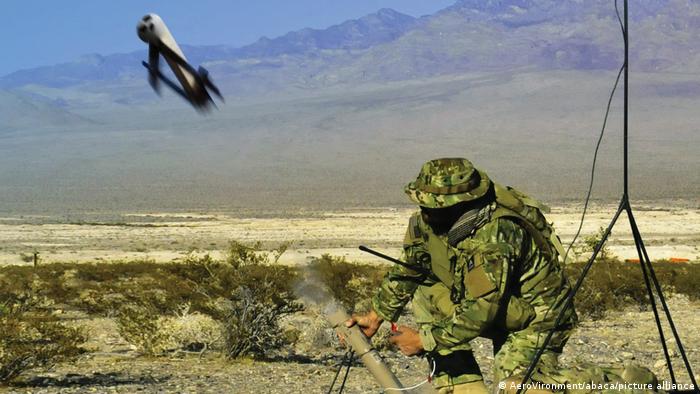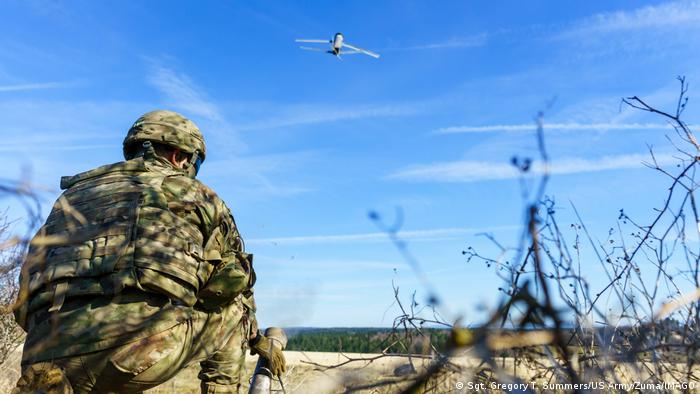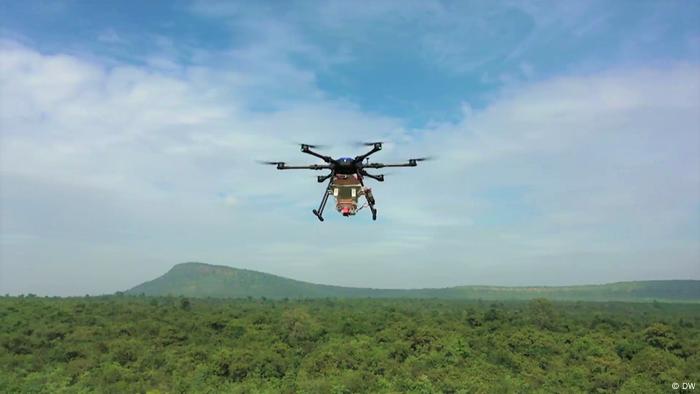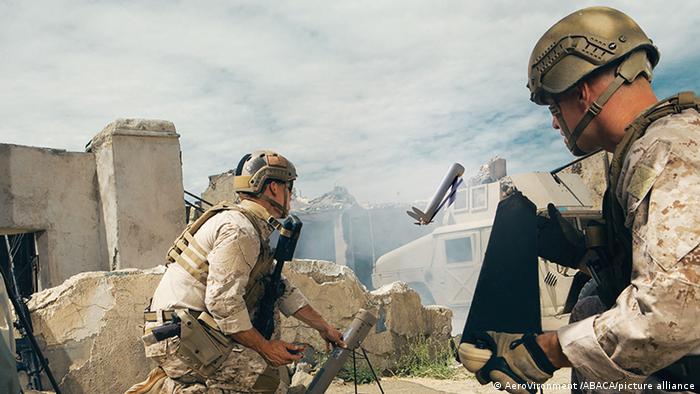[ad_1]
The Ukraine war is clearly showing that drones are part of the modern war. Drones perform a variety of tasks – from aerial surveillance to rocket launching.
According to Pentagon data, the US has developed a new type of drone, which responds to the requirements of the Ukrainian army and which will continue to adapt: ”Phoenix Ghost” is called the flying machine. “In talks with the Ukrainians about their demands, we concluded that this special apparatus responds very well to their demands, especially for eastern Ukraine,” said Pentagon spokesman John Kirby.
The development of this drone began before the development of the Ukrainian war and will be further developed to adapt to the demands of the Ukrainians. More than 120 such drones will be sent to Ukraine as part of US $ 800 million in military aid. Ever since it became known this is being discussed about the specifics of the Phoenix Ghost: What does it look like? What is the difference with the current weapon systems?
Many things are not known. There are no pictures. The Phoenix Ghost was developed by the American armaments company, Aevex Aerospace in collaboration with the US Air Force, who also did not provide details. Working with drones requires minimal training, Pentagon spokesman Kirby said.
The new drone resembles the so-called Switchblade drones, manufactured by AeroVironment, also American. It was developed for use by US special forces in Afghanistan. In 2012, the US military equipped its troops with them.
Switchblade kamikaze drone
Switchblade drones, backpacks, fall into the category of “Loitering Ammunition” or “Loitering Weapon”, which means something like “ammunition or weapons that are left unused and not in use” .
“They are a mixture of rockets and drones,” Arthur Holland Michel, author and member of the Carnegie Council for Ethics in International Affairs in Barcelona, told Deutsche Wellen.
Loitering Munition or Loitering Weapons are maneuverable weapons that are used with remote control and initially ignited without any specific target, but are released in the target region, where they roam for a long time until via an operator data link. located on the ground, assigns a target which the drone hits. Depending on the model, based on the sensor system, the targets that appear can be detected, classified and attacked autonomously.
The concepts of Loitering Munition or Loitering Weapon are not yet very common. This category of weapons first became known in the war in Bergkarabach 2020, when the Azerbaijanis put into use large quantities of them.
Switchblade drones, which would translate into Albanian as a knife with a spring, exist in different variations. The smallest model weighs 2.5 kilograms, has a radius of 10 kilometers and can hover in the air for 15 minutes. The largest variation weighs 15 kilograms and has a range of 40 kilometers and a flight time of 40 minutes.
Benefit: “Compared to big drones, this guy does not need an aerodrome or a lot of infrastructure to put it to work,” says Michel. “And unlike the missile, the drone has more time to identify the target, to create an image of the situation and to launch the drone missile as if by hand, or to hit the target with the help of a target detector. In this way, the capabilities of both weapon systems are combined. ” Switchblade drones are also called kamikaze drones, because during the attack they also destroy themselves.
Improved: Phoenix Ghost
Phoenix Ghost drones have similar capabilities, but they are not exactly the same, says Kirby. David Deptula, a retired general player, dean of the Mitchell Institute for Space Studies and a member of the Aevex Aerospace venture, gives Politico some more information – which has not yet been confirmed.
According to him, Phoenix Ghosts are also single-use drones, but having six hours of flight can stay in the air much longer than other drones. They also start vertically, saving a lot of space, and can operate at night with infrared sensors, says Deptula. This is effective for use against “semi-heavy ground targets”.
Flag “Bayraktar TB2”
The category of “biggest drones” that Michel talks about includes those fighters and Turkish reconnaissance of the Bayraktar TB2 type. They too are in use in the Ukraine war. The Turkish word “Bayraktar” means in German “Fahnenträger”, in Albanian Flamurtar.
This drone was developed in 2014 by the firm Baykar. The Bayraktar TB2 is 6.50 meters long, 12 meters wide and weighs 420 kilograms. It is completely autonomous, can stay in the air 24 hours non-stop, reaches a flight altitude of 7300 meters and has a maximum speed of about 220 kilometers per hour. In autonomous mode it can be switched on without the direction of any ground coordinator, can fly towards a programmed target, make discoveries, turn around and land on the ground completely independently. The maximum range is 150 kilometers.
“Vector”: German technology for Ukraine
For reconnaissance missions the Ukrainian armed forces can now also use the drones of the Bavarian firm, Quantum Systems. “Our first drones are already in fact in Ukraine,” said firm chief Florian Seibel of Redaktions-Netzwerk Deutschland (RND). Other supplies are planned. The London newspaper “The Times” has also written about this.
It took five days from the first contact to the signing of the contract and a little later three Ukrainian fighters sent to Bavaria a selfie with the drones taken. Drohni has the name “Vector” and costs about 180,000 euros. The purchase price was paid by Ukrainian multimillionaires out of pocket, as “assistance to the territorial command in defense of the Dnipro,” reads the article written in the RND.
The link between the fighters and the firm in Bavaria was established by the Ukrainian Consulate in Munich. The German Drone, Vector, is not a weapon in the true sense of the word. He can not throw bombs because it is not done for this job. But if the relevant digital connection is made, it could become part of a weapons system, writes RND.
Vector is very popular because it has very advanced technology in flight and video transfer. The Ukrainians want to use drones to better organize their artillery, for example against approaching Russian tanks.
For this, Vector is perfect: It can be mounted without tools, although the three-meter-wide Vector does not need a runway, ie it rises vertically, just like the Phoenix Ghost. Vector sends high quality real-time video for an area of over 15 kilometers and stays in the air for up to two hours. US special forces have also ordered Vector drones worth 7 million euros and the German army has ordered eight of them, says the head of the firm Seibel for RND.
Ukraine: International Drone Fleet
Japan has also sent drones to Ukraine. According to the Japanese Ministry of Defense, at the request of Ukraine, drones, masks and protective clothing were sent there. But Ukrainian soldiers also use local drones. The most common among them is Leleka-100. The 5-kilogram flying machine is manufactured by the Dnipro-based company Deviro in central Ukraine. “Stork” in the Ukrainian language means stork.
Russia, meanwhile, does not appear to be using drones much. The Orlan 10 drone (eagle / 10), a small reconnaissance and surveillance drone manufactured at the Special Technology Center in St. Petersburg, is in use. With a width of 3.10 meters it flies up to 100 kilometers and can be used to specify artillery strikes. The detection system is very simple: Canon-EOS-D-series aerial shooting cameras as well as camcorders and thermal cameras.
An ethical horror scenario
But despite these steps, the challenges and dangers posed by increasing the autonomy of the weapons system should not be overlooked, admits drone expert Arthur Holland Michel in a twitter message. For example:
Do users in a given situation have enough conscience to make the decision to use violence? Do the weapons offer users enough control to be careful during the attack? Are the weapons manipulative or sensitive to hacker attacks, which can lead to accidents and unpredictable damage? If the system causes unpredictable damage, are there clear channels for people to take responsibility for that damage? How can risks be avoided and safety standards met? How can civilians be protected?
“With each additional autonomous function given to such weapons, concerns are multiplied. “That’s why I want to encourage people to focus on the specific automation functions of these systems and the specific risks that may arise if those functions do not work,” says Michel. The development of weapon systems that are remote controlled or autonomous weapons is advancing rapidly, concerns remain. Autonomous drone wars are an ethical horror scenario./DW
top channel
[ad_2]
Source link




















